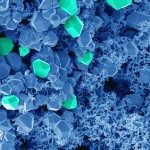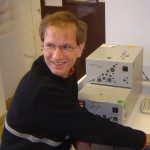Présentation
Séminaire du Département de Biologie Structurale & Chimie
Mardi 6 Février 2018 à 14h00
Salle AUDITORIUM CENTRE F. JACOB – CFJ RdC 17c
Prof. BÜLL Alexander
Institute of Physical Biology – University of Düsseldorf
http://www.ipb.hhu.de/en/teams/teams/team-buell.html
“Insights into the mechanism of amyloid fibril formation by alpha-synuclein”
The aggregation of the intrinsically disordered protein α-synuclein into amyloid fibrils is a hallmark of Parkinson’s disease. In this seminar, I will summarize some progress we have made over the last years in the mechanistic understanding of the aggregation of this protein.
α-synuclein is remarkably stable in solution, because the kinetics of the nucleation process of fibrils is undetectably slow in the absence of suitable interfaces, that induce nucleation. In the presence of lipid vesicles, the nucleation rate is enhanced by several orders of magnitude (1), depending on the chemical nature and phase state of the lipids (2). Therefore, the aggregation of α-synuclein at neutral pH in the presence of lipid vesicles and the absence of mechanical agitation corresponds to a simple nucleated polymerisation reaction. However, at mildly acidic pH (< 5.8), corresponding to conditions encountered by α-synuclein in endosomes and lysosomes, an autocatalytic secondary nucleation process can occur, leading to exponential proliferation of aggregates (3, 4).
Interestingly, the rates of nucleation processes are very differently affected by the disease-related (familial) sequence variants A30P, E46K, A53T, H50Q and G51D, with the individual rate constants differing by several orders of magnitude between these single point mutants (5).
Furthermore, C-terminal truncation of α-synuclein, such as is found in Lewy bodies, leads to strong changes in aggregation behaviour, most notably a shift of the pH window for secondary nucleation into the neutral pH range (6).
We also found that the surface-induced nucleation of α-synuclein can be inhibited by molecules that compete with α-synuclein for surface binding sites, such as the homologous protein β-synuclein (7).
Finally, I will present data on an affibody inhibitor that was designed to bind to monomeric α-synuclein, but turned out to be an extremely efficient inhibitor of the nucleation processes of α-synuclein amyloid fibril formation (8).
References:
(1) Galvagnion et al., Nature Chemical Biology 2015, 11(3), 229-234
(2) Galvagnion et al., PNAS 2016, 113(26), 7065-7070
(3) Buell et al., PNAS 2014, 111(21), 7671-7676
(4) Gaspar et al., Ann. Rev. Biophys 2017, 50, e6, 1-12
(5) Flagmeier et al., PNAS 2016, 113(37), 10328-10333
(6) van der Wateren et al., under review
(7) Brown et al., Scientific Reports 2016, 6, 36010
(8) Flagmeier et al., under review
Contact : Patrick ENGLAND
Plate-Forme de Biophysique Moléculaire
patrick.england@pasteur.fr

